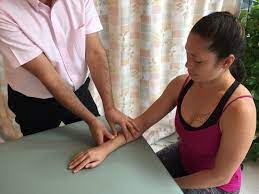
Introduction: De Quervain syndrome, also known as de Quervain’s tenosynovitis, is a painful condition affecting the tendons on the thumb side of your wrist. While various treatments exist, massage therapy is gaining recognition as a non-invasive and effective approach to alleviate symptoms and improve mobility. In this article, we delve into the specifics of De Quervain syndrome massage, exploring techniques, benefits, precautions, and frequently asked questions.
H2: What is De Quervain Syndrome? De Quervain syndrome is characterized by inflammation of the tendons and their sheaths in the thumb side of the wrist. It typically de quervain syndrome massage manifests as pain, swelling, and difficulty moving the thumb and wrist. The condition is often caused by repetitive hand and wrist movements, such as those performed during activities like typing, gaming, or lifting objects.
H3: Understanding De Quervain Syndrome Massage Techniques Massage therapy for De Quervain syndrome involves gentle manipulation of the affected area to reduce pain, inflammation, and stiffness. Here are some common techniques employed:
- Deep Tissue Massage: This technique targets the deeper layers of muscles and tendons to release tension and improve circulation.
- Friction Massage: By applying pressure and friction to the affected tendons, friction massage helps break down scar tissue and alleviate discomfort.
- Trigger Point Therapy: Focused pressure is applied to specific trigger points to relieve pain and restore normal muscle function.
- Stretching Exercises: Incorporating stretching exercises into massage sessions helps increase flexibility and range of motion in the affected wrist and thumb.
H2: Benefits of De Quervain Syndrome Massage Massage therapy offers numerous benefits for individuals suffering from De Quervain syndrome:
- Pain Relief: Massage helps alleviate pain associated with inflamed tendons, providing relief and improving overall comfort.
- Improved Range of Motion: Regular massage sessions can help restore flexibility and mobility in the affected wrist and thumb.
- Reduced Inflammation: Massage techniques de quervain syndrome massage promote better blood circulation, which aids in reducing inflammation and swelling.
- Stress Reduction: De Quervain syndrome can cause significant stress and discomfort. Massage therapy not only targets physical symptoms but also promotes relaxation and stress relief.
H3: Precautions for De Quervain Syndrome Massage While massage therapy can be beneficial for De Quervain syndrome, certain precautions should be observed:
- Avoid Aggressive Techniques: Gentle, non-aggressive massage techniques are recommended to prevent exacerbating symptoms.
- Communicate with Your Massage Therapist: Inform your massage therapist about your condition, symptoms, and any specific concerns you may have.
- Monitor for Discomfort: If you experience increased pain or discomfort during or after a massage session, discontinue the treatment and consult with your healthcare provider.
FAQs:
- Is massage therapy suitable for all cases of De Quervain syndrome? While massage therapy can be beneficial, it may not be suitable for severe cases or those with underlying medical conditions. Consultation with a healthcare provider is recommended.
- How often should I undergo massage therapy for De Quervain syndrome? The frequency of massage therapy sessions can vary depending on individual needs and the severity of symptoms. Your massage therapist can provide guidance on the recommended schedule.
- Can I perform self-massage at home for De Quervain syndrome? Self-massage techniques, such as gentle stretching and applying pressure to tender areas, can complement professional treatment. However, it’s essential to learn proper techniques and avoid excessive force to prevent further injury.
Conclusion: De Quervain syndrome massage offers a holistic approach to managing symptoms and improving quality of life for individuals affected by this condition. By understanding the techniques, benefits, and precautions associated with massage therapy, individuals can make informed decisions about incorporating it into their treatment plan. Always consult with a healthcare provider or qualified massage therapist to ensure safe and effective management of De Quervain syndrome.